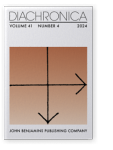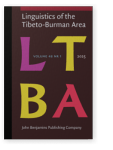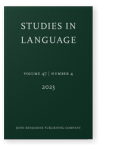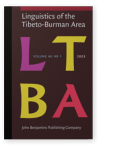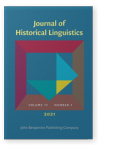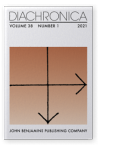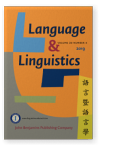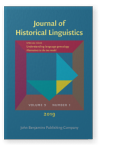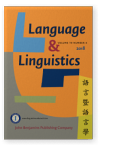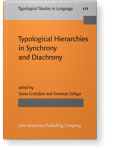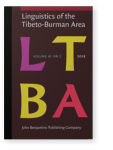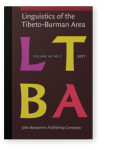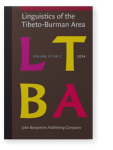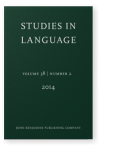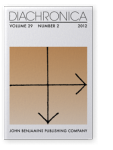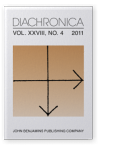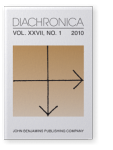Guillaume Jacques
List of John Benjamins publications for which Guillaume Jacques plays a role.
Journals
ISSN 0731-3500 | E-ISSN 2214-5907
2025 Weaving and loom terminology in Japhug Linguistics of the Tibeto-Burman Area 48:1, pp. 44–61 | Article
We describe the yarn preparation and weaving tradition of the Japhug people of Sichuan Province, China, speakers of a Rgyalrongic language belonging to the Sino-Tibetan family. We discuss the practical aspects of the loom and its operation, as well as the terms used to describe it. Our analysis… read more
2023 Simulative derivations in crosslinguistic perspective and their diachronic sources Studies in Language 47:4, pp. 957–988 | Article
This article deals with simulative derivations, meaning ‘pretend (to be) X’, where X stands for a verb or a noun. It shows that these derivations have three main origins: incorporation, denominal derivation and combination of reflexive and causative. It also systematically discusses the… read more
2023 Elevational deixis in the Kiranti verb Linguistics of the Tibeto-Burman Area 46:1, pp. 6–34 | Article
This article deals with elevational deixis in Kiranti languages, a feature which is pervasive in these languages in both the verbal and nominal domains. The system of elevation is described in most grammars of these languages as tripartite, following the typologically common system comprising… read more
2021 Chapter 13. Antipassive derivations in Sino-Tibetan/Trans-Himalayan and their sources Antipassive: Typology, diachrony, and related constructions, Janic, Katarzyna and Alena Witzlack-Makarevich (eds.), pp. 427–446 | Chapter
This paper presents an overview of antipassive constructions in the Sino-Tibetan/Trans-Himalayan family. It shows that all of these constructions are relatively recent developments, and originate from three distinct historical sources, including the incorporation of generic nouns, the… read more
2021 Phylogenies based on lexical innovations refute the Rung hypothesis Diachronica 38:1, pp. 1–24 | Article
Sino-Tibetan (Trans-Himalayan) is one of the typologically most diverse language families in the world, one of the few comprising all gradients of morphological complexity, from isolating to polysynthetic. No consensus exists as yet on whether the rich morphology found in some languages, in… read more
2019 Egophoric marking and person indexation in Japhug Language and Linguistics 20:4, pp. 515–534 | Article
Japhug, like other Gyalrong languages, is one of the very few languages with both a full-fledged person indexation system and an egophoric evidential category. A detailed account of the uses and meanings of the Egophoric and its interaction with person is thus of interest to the typology of… read more
2019 Save the trees: Why we need tree models in linguistic reconstruction (and when we should apply them) Understanding language genealogy: Alternatives to the tree model, Kalyan, Siva, Alexandre François and Harald Hammarström (eds.), pp. 128–167 | Article
Skepticism regarding the tree model has a long tradition in historical linguistics. Although scholars have emphasized that the tree model and its long-standing counterpart, the wave theory, are not necessarily incompatible, the opinion that family trees are unrealistic and should be completely… read more
2018 Associated motion in Manchu in typological perspective Language and Linguistics 19:4, pp. 501–524 | Article
The present paper presents a detailed description of the Associated Motion system of Classical Manchu, on the basis of original texts from the 17–18th centuries. It shows that despite superficial similarities, Classical Manchu differs in many ways from previously described AM systems only… read more
2018 Chapter 12. Generic person marking in Japhug and other Gyalrong languages Typological Hierarchies in Synchrony and Diachrony, Cristofaro, Sonia and Fernando Zúñiga (eds.), pp. 403–424 | Chapter
This paper discusses the history of generic person marking systems in several Gyalrong languages. While closely related, Japhug and Tshobdun differ considerably: the inverse prefix marks generic A in Japhug, while it appears in the generic P form in Tshobdun. We propose a historical scenario to… read more
2018 Bipartite verbs in Japhug and other Trans-Himalayan languages Linguistics of the Tibeto-Burman Area 41:2, pp. 175–191 | Article
This paper presents an overview of bipartite verbs in Japhug and describes related constructions in that language, including compound and serial verbs. Several hypotheses are proposed to account for the genesis of these constructions and the historical relationship between them. Typological… read more
2018 Chapter 7. The direction(s) of analogical change in direct/inverse systems Typological Hierarchies in Synchrony and Diachrony, Cristofaro, Sonia and Fernando Zúñiga (eds.), pp. 257–288 | Chapter
In this chapter, we extract general principles of language change from the study of the evolution of the conjunct order in various Algonquian languages, and propose four generalizations concerning the directionality of the spread of analogy in these systems. These generalizations are expected to… read more
2017 A note on volitional and non-volitional prefixes in Gyalrong languages Linguistics of the Tibeto-Burman Area 40:2, pp. 124–132 | Article
This paper addresses Prins’ (2016) recent proposal of a m(ə)‑ non-volitional prefix in the Kyomkyo dialect of Situ, showing that alternative analyses are preferable. In addition, it offers an account of some irregular anticausative forms in Situ, and presents evidence for a possible volitional… read more
2016 From ergative to comparee marker: Multiple reanalyses and polyfunctionality Diachronica 33:1, pp. 1–30 | Article
This article describes the uses of the marker kɯ in Japhug, which presents many distinct functions, including ergative, instrumental, distributive, causal linker, manner linker and comparee marker in the comparative construction. A series of grammaticalization pathways, some of which have never… read more
2016 Complementation in Japhug Gyalrong Linguistics of the Tibeto-Burman Area 39:2, pp. 222–281 | Article
This article provides a detailed survey of complement clauses and complementation strategies in Japhug. It shows the bewildering diversity of constructions attested in these languages, which are largely unpredictable and need to be specified for each complement-taking verb. Special focus is given… read more
2016 Reflexive paradigms in Khaling Linguistics of the Tibeto-Burman Area 39:1, pp. 33–48 | Article
Khaling, like other Kiranti languages, has a Reflexive / Middle suffix-si, the main function of which is to reduce the valence of verbs. The present paper describes the complex morphological alternations observed in the reflexive paradigms, and provides a detailed account of the various meanings of… read more
2015 The spontaneous-autobenefactive prefix in Japhug Rgyalrong Linguistics of the Tibeto-Burman Area 38:2, pp. 271–291 | Article
This paper documents the morphosyntactic and semantic properties of the autobenefactive-spontaneous prefix nɯ-. It describes the regular and irregular morphological and morphophonological alternations displayed by this prefix, as well as its three main semantic functions, namely spontaneous,… read more
2015 Review of Ding (2014): A grammar of Pumi Linguistics of the Tibeto-Burman Area 38:2, pp. 319–323 | Review
2014 Clause linking in Japhug Linguistics of the Tibeto-Burman Area 37:2, pp. 264–328 | Article
This paper presents a detailed description of clause linking in Japhug, based on a corpus of traditional narratives and conversations. It follows the methodology used in Dixon and Aikhenvald’s (2009) collective book on this topic, to ease crosslinguistic comparisons. Although Japhug has a very… read more
2014 The auditory demonstrative in Khaling Studies in Language 38:2, pp. 393–404 | Article
This paper shows the existence of an auditory demonstrative in Khaling. The use of the demonstrative is illustrated via examples taken from narrative discourse. It is described here within the context of the spatial demonstrative system, in order to demonstrate how it is specifically used to… read more
2012 Historical transfer of nasality between consonantal onset and vowel: From C to V or from V to C? Diachronica 29:2, pp. 201–230 | Article
Comparative data from several language families show that nasality can be transferred between a syllable-initial consonant cluster and the following vowel. The cases reported to date are summarized, and a new analysis is proposed for a set of Sino-Tibetan data. The evolution appears to go in both… read more
2011 Approaching the historical phonology of three highly eroded Sino-Tibetan languages: Naxi, Na and Laze Diachronica 28:4, pp. 468–498 | Article
Naxi, Na and Laze are three languages whose position within Sino-Tibetan is controversial. We propose that they are descended from a common ancestor (‘Proto-Naish’). Unlike conservative languages of the family, such as Rgyalrong and Tibetan, which have consonant clusters and final consonants, Naxi,… read more
2010 Review of Kane (2009): The Khitan Language and Script Diachronica 27:1, pp. 157–165 | Review
